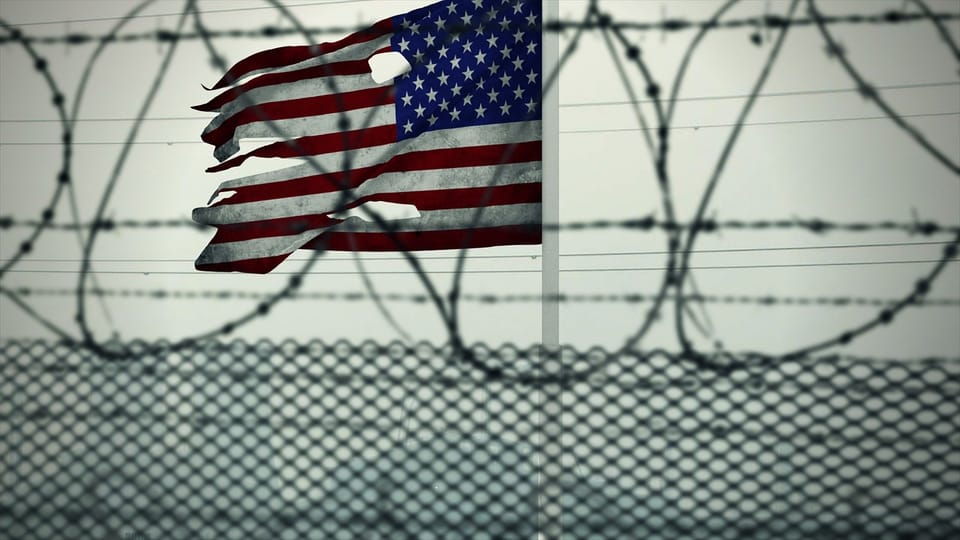"It was dehumanizing" - Inside A Transgender Immigrant's Illegal Detention in Guantanamo Bay

Legal organizations filed multiple declarations last month on behalf of documented immigrants illegally sent to Guantanamo Bay (‘Gitmo’), an infamous military prison known for dehumanizing inmates — including one on behalf of a transgender woman who was housed with men.
The lawsuit, Espinoza Escalona v. Noem, was jointly filed by the American Civil Liberties Union (ACLU), Center for Constitutional Rights (CCR), and the International Refugee Assistance Project (IRAP). It aims to prevent immigrants unlawfully detained by Immigrations and Customs Enforcement (ICE) from being sent to Guantanamo.
“I was housed in a room with five men, as if I am a man. I told the guards that I am a transgender woman and that I didn’t feel comfortable or safe being housed with men, but they didn’t care or do anything to address my concerns. The guards there did not treat me like I was human,” said Tarlis Marcone de Barros Gonçalves, an immigrant from Brazil who only speaks Portuguese, in her translated declaration.
“We were only let outside to see the sun for a maximum of 25 minutes a day. Every time I was let outside or went back inside, I was searched by male guards. I even complained about it and requested that I not be searched by men since I am a woman. The guard only responded in English and nothing changed.”
In the declaration, De Barros Gonçalves described how she fled Brazil out of fear for her life after receiving repeated threats. Her experiences are not uncommon among LGBTQ+ Latin Americans — in 2023, more than 250 LGBTQ+ Brazilians were murdered, including over 100 trans victims.
Transphobic politicians, such as disgraced admirer of Donald Trump and former prime minister Jair Bolsonaro, contributed to this by openly inciting the hatred of gender and sexual minorities and thus enabling far-right groups who actively target LGBTQ+ individuals, something experts have likened to witch hunts. This trend extends across Latin America as well, including in regions like Mexico and Colombia.
“On or around February 15, 2025, I entered the United States from Mexico near El Paso, Texas where I was apprehended by U.S. authorities,” declared De Barros Gonçalves. “An officer asked if I would sign a deportation order, but I refused because I am afraid for my life in Brazil.”
De Barros Gonçalves described how ICE and Guantanamo Bay prison guards refused to communicate with her, responding only in English while brandishing rifles right outside her cell’s door. She continued, “Every time I went to the bathroom or when I showered, I was in view of everyone — there was no door to provide me with any privacy. As a woman, it was a dehumanizing experience. I was also only given one pair of clothes to wear the entire time.”
During her time at Gitmo, she was effectively starving. “There was also very little food to eat and I was constantly hungry. We only got two meals a day — once in the morning and once in the afternoon. The meals would only have salad, rice, a small piece of meat, and one fruit,” she recounted.
None of this was for a lack of trying to improve her conditions. De Barros Gonçalves repeatedly asked the supervising officer “to do something to protect me because I am transgender. I cried, told her I had not signed any deportation paperwork, and requested to contact my family and my attorney. But she refused to do anything.” None of the officials gave her information regarding the full extent of her rights under the law.
Her mistreatment continued even as she was escorted out of Gitmo. Five days after her incarceration at the facility, the guards put her on a plane to Miami before transporting her to Pine Prairie, Louisiana, where she is currently imprisoned.
“They shackled me again on my wrists, feet, and hips and put me back on a plane. They didn’t tell me where we were going. I didn’t know I was back in the United States until we landed and the ICE officer told me we were in Miami. They shackled me so tightly that I was in pain for several days after the flight. They had to give me pain medication,” she recounted. She is currently held in solitary confinement.
Unfortunately, De Barros Gonçalves’ experiences are not a one-off occurrence — Free Radical’s Mira Lazine interviewed another trans woman detained by ICE earlier this year for Assigned Media. Marisol Ordonez Vargas was deprived of essential medication for a broken nose, was deprived of basic food and hygiene products, and was held in solitary for days on end. She was sexually harassed and raped by other detainees, information she withheld from guards due to their previous behavior of laughing at her sobs from her untreated fractured nose.
According to Vargas’ initial lawsuit, she had broken no laws.
This mirrors the experiences of De Barros Gonçalves while she was held in standard processing centers for asylum seekers. Shortly after she refused to sign a deportation order, she was transferred to Otero County Processing Center in New Mexico and placed in a unit with 49 men, who continuously harassed and insulted her. Her transfer to Gitmo was similar to her eventual departure — shackled on her wrists, feet, and hips without communication from officials.
According to Eunice Cho, the ACLU’s senior attorney on the case who spoke to the Free Radical, these experiences are “unfortunately not uncommon for people in detention.” However, she emphasized that De Barros Gonçalves’ detainment in Guantanamo Bay, a prison originally meant to detain those deemed “terrorists” or “threats to the state,” is particularly unusual. “Guantanamo is unique in that it is located on a military base. But I do think that as in other carceral spaces, including prisons, jails, and immigration detention facilities, people who are trans are unfortunately often placed in units not of their gender and can be subject to degrading, humiliating, and inhumane treatment as a result.”
Cho further noted that utilizing Gitmo to detain immigrants had never been done before, referring to its traditional usage for military and political prisoners. “The government has clearly said that they're using Guantanamo to try to deter people from immigrating to the United States,” she wrote. “That's not a legally acceptable reason to detain anybody at any particular location.… It makes no rational sense. And it seems that the government is trying to really create more of a spectacle than anything.”
Horrifically, this abuse is indeed common to both trans prisoners and immigrants. There are countless horror stories from ICE facilities of trans immigrants being deprived of essential medical care, with one investigation finding that at least one trans woman has died in ICE custody. Others were berated and insulted by guards, and many immigrants have been outright tortured by ICE personnel.
Despite the maltreatment, this system continues to be actively maintained by those in power. Recently, the Supreme Court overturned orders temporarily restraining the Trump administration’s mass deportations, including of legal immigrants, deciding that they must be resolved on a case-by-case basis. Centrist Democrats have notoriously fought against efforts to abolish this institution, with polls finding that a majority of Democrats seek to maintain and reform it, including former Vice President Kamala Harris.
In spite of this, now more than ever is it important for people to not lose hope, and to instead see this injustice as reason to fight even harder against the institutions that oppress our neighbors. Cho highlighted a number of ways people can fight back, from contacting members of Congress to signing petitions with the ACLU to providing direct support for immigrants in their local communities.
Putting a particular emphasis on community support, she explained, “It's very important to help support those locals in your community by attending Know Your Rights workshops, supporting and enacting helpful Know Your Rights plans in your community so that people aren't illegally and indiscriminately picked up by immigration enforcement.”
The most effective strategies often involve coordination at the local level. Institutions like the National Immigrant Justice Center provide detailed information to help inform immigrants of their legal rights in the country, including guidance on what to do when encountering law enforcement. Coordinating the spread of this information is crucial, and may often involve getting in touch with local pro bono immigration attorneys, many of whom operate within larger cities across the country. Websites like Immigration Law Help are useful for identifying specific practices, something also found in the National Immigration Legal Services Directory. The Immigrant Legal Resource Center has similar guides that can be printed out and distributed to immigrants in your community, and these guides are written in over a dozen different languages.
Other ways people can help include connecting immigrants to local mutual aid networks for the distribution of essential materials like food, clothing, and medical supplies. Assistance can be found through a variety of decentralized groups, many locality-specific, including Food Not Bombs and the Anarchist Black Cross. Fiscal donations to immigrants can additionally be some of the most helpful means of support.
Above all else, however, it is worth getting connected to established, decentralized, and non-hierarchical activist networks in your area if you want to help. Most major cities in the United States have some kind of local mutual aid scene, and many of the activists in these scenes have been doing this work for decades. Even if you’re outside of a major metropolitan area, those in your nearest city can often connect you to activists doing work right next door. Groups like CrimethInc have detailed guides on how you can not only employ safe practices in fighting against ICE, but also on how you can get plugged into rapid response networks near you.
As fascism rises, your community can become your greatest asset in protecting you and your neighbors from the threats of law enforcement agencies. No matter who you are, there are ways you can either give or receive help. The best time to get involved was yesterday, the second best time to get plugged in is right now — it’s never too late to fight back.
Thank you to Ryan Fae (@ryan.staticnoi.se) for editing this article.

Member discussion